Featuring interchangeable lenses that auto-calibrate with the camera, as well as a vibrant 4" touchscreen with scratch-resistant Dragontrail™ cover glass and a fast and responsive interface.
Featuring interchangeable lenses that auto-calibrate with the camera, as well as a vibrant 4" touchscreen with scratch-resistant Dragontrail™ cover glass and a fast and responsive interface.
Discontinued!
This product has been discontinued and is no longer available.
This is the direct replacement:
Featuring interchangeable telephoto lenses (24°, 42°, 14°) that can be set up to auto-calibrate with the camera for quick swapping in the field with little down time and no need to send to the factory.
A brighter and larger display with auto-rotation helps you clearly see small details even before you look at your report.
A fast and responsive interface allows for ease of use and the improved organization and reporting options makes diagnosing your reports easy.
Not every target is the same size out in the field. The interchangeable lenses (14°, 24°, 42°) will allow you to get the shot you need with the same camera for every situation. From wide angle to telephoto, the lenses offer complete coverage of near and far targets. Each lens can be set up to auto-calibrate with the camera for quick swapping in the field with little down time and no need to send to the factory.
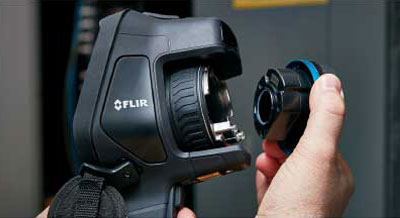
The camera produces radiometric JPEGs that can be opened in your own software. No need for a proprietary one. The images are supported by FLIR's Strategic Developers Kit (ATLAS SDK). This enables companies to use their own CMMs. With their own CMMs they can store and pull measurements from thermal images. Other information stored in the image are also accessible like GPS, compass, current and voltage measurements.
Your job can take you into all kinds of different places and positions. With the simple buttons and being lightweight using the camera in one hand is easy. If you are in a dark space the large and bright LED screen will allow you to clearly see what your investigating.
Report problems in building structures for insurance claims, pre-insurance audits, and building inspections. The Exx-Series improves plant safety by helping you diagnose and report electrical problems before they result in fire or damage.
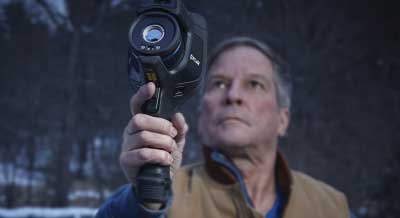
Equipment failures are costly and can impact on time delivery, so it's important to have the right tools to find potential problems before they happen.
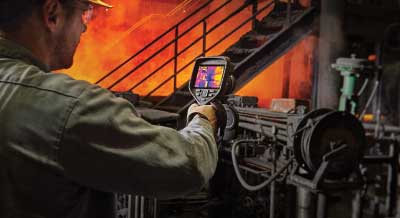
Laser focus has a dual trigger allowing a more intuitive focus to happen before capturing the image.
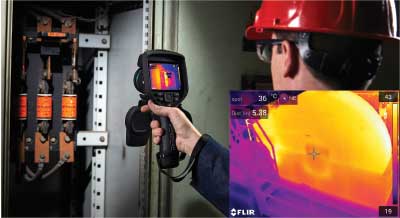
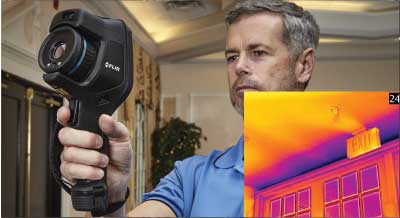
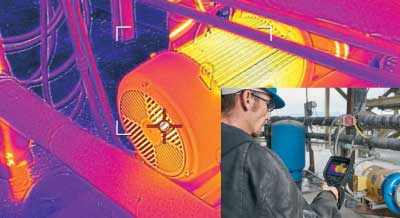
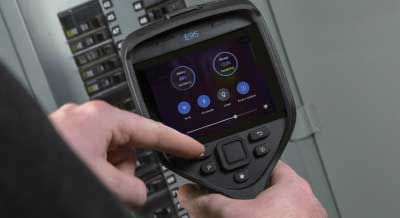
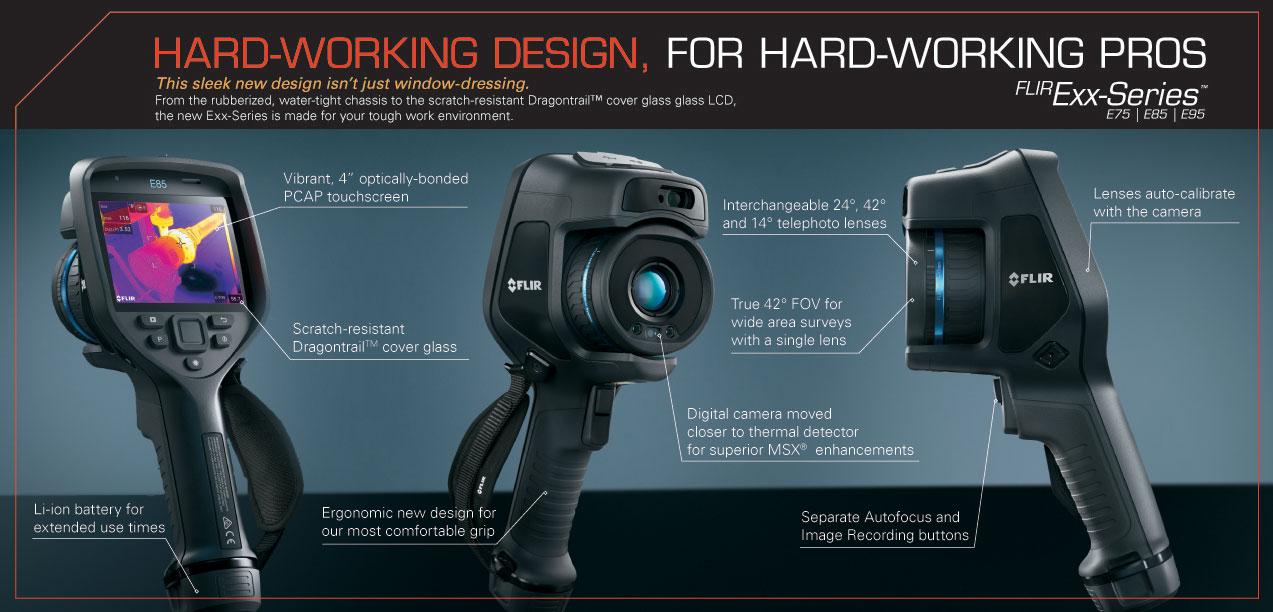
| IR Resolution | 464 x 348 (161,472 pixels) |
| Object Temperature Range | -20 to 120°C (-4 to 248°F) 0 to 650°C (32 to 1200°F) 300 to 1500°C (572 to 2732°F) |
| Time-lapse (Infrared) | 10 sec to 24 hours |
| Area Measurement Information | Yes |
| Spotmeter | 3 in live mode |
| Area | 3 in live mode |
| Detector Type and Pitch | Uncooled microbolometer, 17 µm |
| Thermal Sensitivity/NETD | < 0.03°C @ 30°C (86°F) |
| Spectral Range | 7.5 - 14.0 µm |
| Image Frequency | 30 Hz |
| Field of View (FOV) | 42° x 32° (10 mm lens), 24° x 18° (17 mm lens), 14° x 10° (29 mm lens) |
| Display | 4", 640 x 480 optically-bonded PCAP touchscreen, with 400 cd/m2 surface brightness |
| Picture-in-Picture | Resizable and movable |
| MSX® | Embosses visual details on full resolution thermal image |
| UltraMax™ | Super-resolution process quadruples pixel count, activated in FLIR Tools+ |
| Accuracy | ±2°C (±3.6°F) or ±2% of reading for ambient temperature 15 to 35°C (59 to 95°F) and object temperature above 0°C (32°F) |
| Battery Operating Time | Approximately 2.5 hours at 25°C (77°F) ambient temperature and typical use |
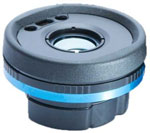
Today’s customers get to choose between 14, 24 or 42 degree lenses, but the question is… what to choose? We can help!
Here you’ll find a gathering of various building component or electrical component images that I have taken as well as my guidelines for each type of inspection.
The 24˚ lens is an excellent in-between option, however I feel the 42˚ lens will be the better choice for most applications.

In these applications the distance is longer and it’s important to take this into consideration. Ideally if you’re prepared to invest in more than one lens, my recommendation would be the 42˚ and 14˚ lenses. Since you will need to carry out both short distance audits and long distance audits. If you’re only interested in buying one lens, then the 24˚ lens is the best choice.
If your are working with IR windows on your electrical cabinet 42˚ lens would be your go to. Given that you need to be up close and personal with the windows so the shorter distance lens is the way you want to go.
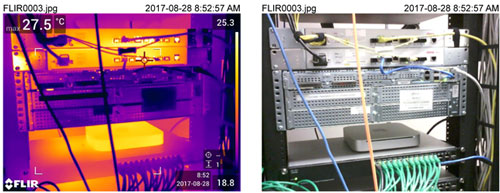
Give the often short distances available to get the full span of shelves in computer rooms the 42˚ lens is the best choice, as you can see a 19” shelf at a short distance.
A final note, doubling the resolution is ideal for any application, by using the E95 or T540 over the E75 or T530 you get almost equivalent pixel resolution using a 42˚ lens over the 24˚ lens. Example at a 5 meter distance the IFOV (size of one pixel) will be 6.60 mm (E75-24) & 7.81mm (E95-42). It is almost like having 2 lenses in one.
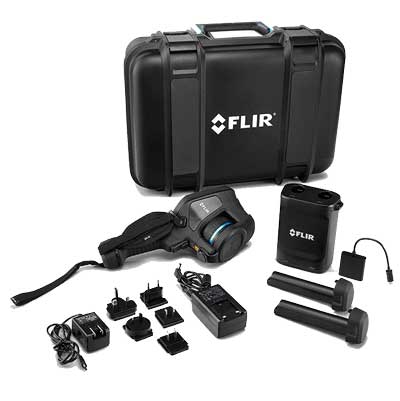
Click on a category to view a selection of compatible accessories with the FLIR E95 Thermal Imaging Camera, 464 x 348 with 14° Lens.
| IR Resolution | 464 x 348 (161,472 pixels) |
| Object Temperature Range | -20 to 120°C (-4 to 248°F) 0 to 650°C (32 to 1200°F) 300 to 1500°C (572 to 2732°F) |
| Time-lapse (Infrared) | 10 sec to 24 hours |
| Area Measurement Information | Yes |
| Spotmeter | 3 in live mode |
| Area | 3 in live mode |
| Detector Type and Pitch | Uncooled microbolometer, 17 µm |
| Thermal Sensitivity/NETD | < 0.03°C @ 30°C (86°F) |
| Spectral Range | 7.5 - 14.0 µm |
| Image Frequency | 30 Hz |
| Field of View (FOV) | 42° x 32° (10 mm lens), 24° x 18° (17 mm lens), 14° x 10° (29 mm lens) |
| Display | 4", 640 x 480 optically-bonded PCAP touchscreen, with 400 cd/m2 surface brightness |
| Picture-in-Picture | Resizable and movable |
| MSX® | Embosses visual details on full resolution thermal image |
| UltraMax™ | Super-resolution process quadruples pixel count, activated in FLIR Tools+ |
| Accuracy | ±2°C (±3.6°F) or ±2% of reading for ambient temperature 15 to 35°C (59 to 95°F) and object temperature above 0°C (32°F) |
| Battery Operating Time | Approximately 2.5 hours at 25°C (77°F) ambient temperature and typical use |

Today’s customers get to choose between 14, 24 or 42 degree lenses, but the question is… what to choose? We can help!
Here you’ll find a gathering of various building component or electrical component images that I have taken as well as my guidelines for each type of inspection.
The 24˚ lens is an excellent in-between option, however I feel the 42˚ lens will be the better choice for most applications.

In these applications the distance is longer and it’s important to take this into consideration. Ideally if you’re prepared to invest in more than one lens, my recommendation would be the 42˚ and 14˚ lenses. Since you will need to carry out both short distance audits and long distance audits. If you’re only interested in buying one lens, then the 24˚ lens is the best choice.
If your are working with IR windows on your electrical cabinet 42˚ lens would be your go to. Given that you need to be up close and personal with the windows so the shorter distance lens is the way you want to go.

Give the often short distances available to get the full span of shelves in computer rooms the 42˚ lens is the best choice, as you can see a 19” shelf at a short distance.
A final note, doubling the resolution is ideal for any application, by using the E95 or T540 over the E75 or T530 you get almost equivalent pixel resolution using a 42˚ lens over the 24˚ lens. Example at a 5 meter distance the IFOV (size of one pixel) will be 6.60 mm (E75-24) & 7.81mm (E95-42). It is almost like having 2 lenses in one.

Click on a category to view a selection of compatible accessories with the FLIR E95 Thermal Imaging Camera, 464 x 348 with 14° Lens.